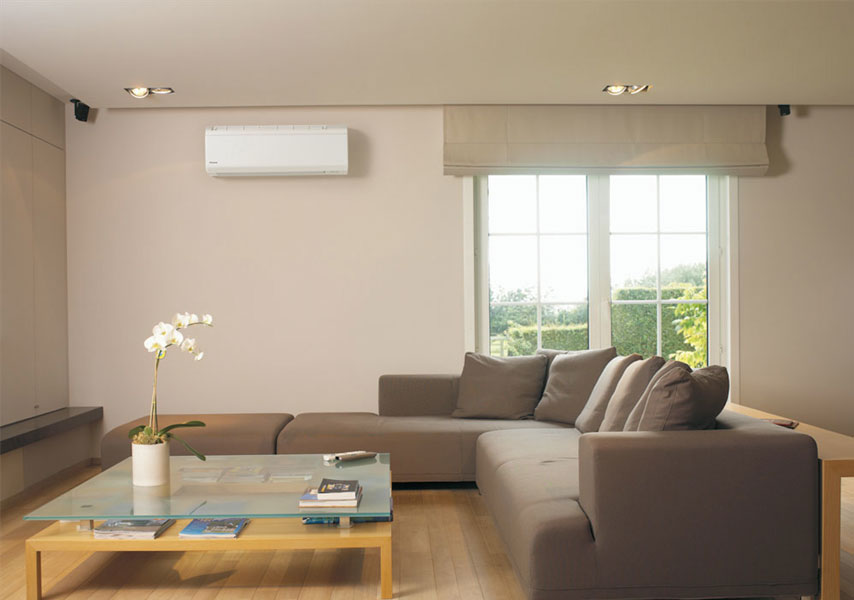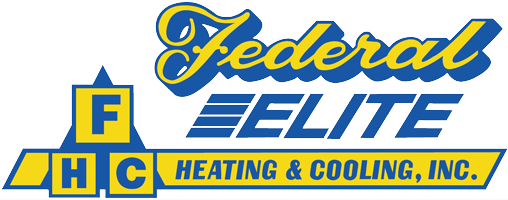Residential Ductless Heating & Cooling Systems
Installing central air conditioning in a home that does not have forced air ducts can be difficult. Ductless mini-split heat pumps provide a unique solution to bringing central air conditioning into homes. By piping refrigerant to individual coils within air handlers mounted throughout a home Air flow from the heat pump through multiple refrigerant lines to multiple rooms, and out the air vent. (rather than a single refrigerant coil/air handler and central ductwork), mini-split heat pumps do not require ductwork for central air conditioning. Because the refrigerant lines take up much less room than do typical ducts, much less effort is required in installation in a retrofit.
Ductless mini-split systems combine the flexibility of room air conditioners with the whole house cooling of central systems. Although some systems provide heating and cooling, ductless mini-split heat pumps are usually installed primarily for cooling.
In a conventional heat pump, a single indoor unit (refrigerant coil and air handler) and single outdoor unit (condenser and compressor) serve the entire house. Air is cooled at the evaporator coil and distributed around the house via ductwork. In ductless systems, there is (usually only) one outdoor unit serving multiple indoor units (each containing a refrigerant coil and blower). Refrigerant is piped from the outdoor unit through small-diameter insulated refrigerant lines directly to individual rooms or zones. Cooled air is blown into the room by a fan in the individual evaporator units. The term "mini" is used to describe the small indoor units located in each room or zone.
While distribution energy losses in conventional systems have been estimated as high as 30 percent, distribution losses for ductless systems are about one to five percent.
Attributes
Because they do not rely on ductwork (which is often leaky and can account for a third of the energy usage for heating and cooling), mini-split heat pumps can boost energy efficiency. The ability to control each zone separately can also contribute to energy efficiency.
Ease of Implementation
Ductless heat pumps are installed using conventional methods for heat pump/air conditioner installation. However, extra care must be taken to prevent refrigeration leaks and to ensure proper operating pressures.
Operational Cost
Ductless systems can reduce energy costs for heating and cooling over conventional heat pumps. Cost will vary with equipment efficiency rating and the leakiness (and location) of ducts to which it is compared.
U.S.Code Acceptance
Few, if any, code or regulatory barriers limit ductless technology. The National Appliance Energy Conservation Act of 1992 requires that split systems have a minimum SEER of 10.0 and HSPF of 6.8. In 2006, these minimum requirements will increase to 13 SEER and 7.7 HSPF. The Air-Conditioning and Refrigeration Institute provides a list of air conditioners and heat pumps and their rated efficiency.
Installation
Ductless systems are relatively easy to install. It takes two installers about a day to install a system having up to three zones. Wiring for power and controls is easier than with a conventional unit since wires can be run along with the refrigerant lines. Refrigerant lines from outdoor units can span up to one hundred feet to indoor units.
Indoor units are about six to eight inches deep and are mounted flush on a wall or ceiling, or recessed in a drop ceiling. A three-inch hole behind the unit is used for attaching wiring, refrigerant lines, control cables, and a condensate drain.
Warranty
Warranty varies with manufacture. A typical warranty is one year on indoor units and up to six years on compressors.
Benefits/Costs
Ductless system benefits include ease of installation-air ducts are bulky and require special structural attention, while split system piping can often be routed through walls and joists. Further, split systems allow zone control for increased comfort and efficiency. System energy losses are reduced because distribution takes place through insulated refrigeration lines rather than ductwork. Aesthetics are improved over window units and no windows need to be blocked. Each zone has its own thermostat, so occupants can modify temperatures in each zone.
Advantages
The main advantages of mini splits are their small size and flexibility for zoning or heating and cooling individual rooms. Many models can have as many as four indoor air handling units (for four zones or rooms) connected to one outdoor unit. The number depends on how much heating or cooling is required for the building or each zone (which in turn is affected by how well the building is insulated). Since each of the zones will have its own thermostat, you only need to condition that place when someone is there. This will save energy and money.
Ductless mini-split systems are also often easier to install than other types of space conditioning systems. For example, the hook-up between the outdoor and indoor units generally requires only a three-inch hole through a wall for the conduit. Also, most manufacturers of this type of system can provide a variety of lengths of connecting conduits. If necessary, you can locate the outdoor unit as far away as 50 feet from the indoor evaporator. This makes it possible to cool rooms on the front side of a building house with the compressor in a more advantageous or inconspicuous place on the outside of the building.
Since mini splits have no ducts, they avoid the energy losses associated with ductwork of central forced air systems. Duct losses can account for more than 30% of energy consumption for space conditioning, especially if the ducts are in an unconditioned space such as an attic.
In comparison to other add-on systems, mini splits offer more flexibility in interior design options. The indoor air handlers can be suspended from a ceiling, mounted flush into a drop ceiling, or hung on a wall. Floor-standing models are also available. Most indoor units have profiles of about seven inches deep and usually come with sleek, high tech-looking jackets. Many also offer a remote control to make it easier to turn the system on and off when it's positioned high on a wall or suspended from a ceiling.
Split-systems can also help to keep your home safer since there is only a small hole in the wall. Through-the-wall and window mounted room air-conditioners can provide an easy entrance for intruders.








